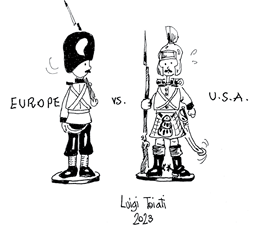
The toy soldier company named after its founder “William Feix” was one of the very first metal toy soldier manufacturers in the United States. Before progressing on to the history and production of this early American master, we should point out that most of the seminal research into William Feix has been done by the late Richard O’Brien, American specialist and collector Bill Nutting, and Len Richards. Their books on collecting Toy Soldiers, and various articles in the Old Toy Soldier Newsletter have given us valuable clues as to the historical progression of this manufacturer. In this article we will try and put together all that we have learned, as well as present a number of illustrations of figures, many previously un-seen, to pique your interest in this pioneering American manufacturer.
Nutting’s research suggests Wilhelm (anglicized to William) Feix was born in Austria in 1866. My own independent ancestry research only confirms this. He immigrated to the United States in 1888 at the age of 22, and apparently began working in the metal trade, either due to experience back in Austria (he would have certainly been eligible for an apprenticeship long before coming over) or connections made in the United States. O’Brien has found him in the 1900 census described as a “manufacturer of metal”, though this is sufficiently vague as to what he was actually making (probably a variety of things).
Imported metal toy soldiers were generally for the children of rich families, as they were expensive and typically sold in high-end venues. Feix’s idea of producing American-made toy soldiers was apparently to make available the quality and allure of the European toy soldiers to American children at a much more reasonable price. By 1903, it appears Feix had started producing toy soldiers at 58 Troutman St. in Brooklyn, NY. Interestingly, this address is close to the Brooklyn business address of Charles W. Beiser, founder of Eureka American Soldiers and the American Soldier Company (1898-1927). O’Brien found an advertisement in a 1903 issue of “Playthings” magazine that illustrated the iconic Feix trooper “on guard” in spiked helmet along with their unique officer, pointing and holding a sword across his body. This suggests Feix started toy soldier production in 1902 or ’03. Ancestral records suggest William Feix died on May 14th, 1925, but the company continued production (presumably by other family members) at least until 1927 or possibly 1928. Feix was registered to appear at a 1928 toy fair, but O’Brien suggests these entries may be from someone who obtained the molds or old stock. There is no record of William Feix toy soldiers after 1928.
What makes the toy soldiers of Feix and also Eureka unique in American production was that they were made in hollowcast, a technique producing a lighter hollow metal shell of a figure from a brass mold that allowed the solid core to be poured out preserving the outer shape and integrity of the figure. Prior to Eureka and Feix, what little American metal production existed was from simple cavity molds, mostly of German origin, that produced a solid-cast demi-round figure. For example, the Schneider/Schiercke molds later sold for home casting (1904-late 1920s). It is quite obvious that Feix and Eureka, like other toy soldier makers from England and France, were purchasing excellent brass hollowcasting molds for their soldiers from Germany. For Feix, the connection was Heyde of Dresden. Perhaps Feix used his old-world connections to tap into the availability of these molds, possibly having them made to his specifications.
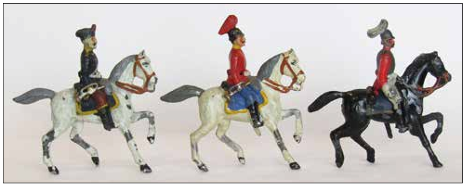
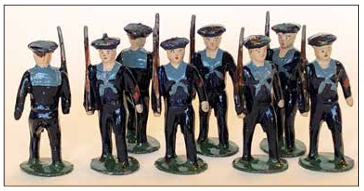
We know that toy soldier folklore suggests Britain’s Ltd. invented hollowcasting, but that is highly unlikely. One only need to look at the early “Germanic” production of their figures in their earliest years to see the German influence. Note Figure 1 which compares the German Heyde hollowcast to both the Britain’s and the Feix mounted figures and you will see they are all pretty much the same. Besides, knowing Britain’s’ aggressive history for protecting their production, it seems even less likely they would share something as valuable as hollowcasting with their competition if it were already theirs. So, it appears that Heyde (and probably other German makers) were willing to sell molds, as well as their soldiers, as part of their business model; providing a European tradition to American-made toy soldiers. A great example is the group of French sailors (Figure 2), manufactured and sold in France, which bear a striking similarity to the Feix sailors.
The actual American production of hollowcasting molds in the United States would not begin until the arrival of the Russian ex-patriot Henry Kassel, who was a sculptor and had learned the art of making hollowcasting molds in England before immigrating to the US in the 1920s. O’Brien documents that he began working with Lincoln Log, and then JE Jones, to make their new truly American made molds for a new generation of American-made toy soldiers.
What makes the early Feix figures stand out is the paint finish, all very much in the German tradition and of highest quality. The early paint, at least up to 1907, and probably up to the beginning of World War 1, was wonderful, but clearly began to slip and become less detailed and crude in later years of production. As is apparent in the many illustrations of this article, the artistry of the detail and colors of their best figures was superior to post WWI painting as well as to that of other makers who were able to purchase or pirate Feix molds.
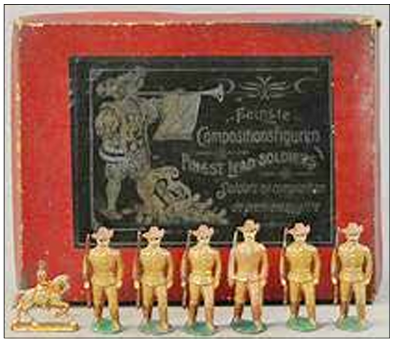
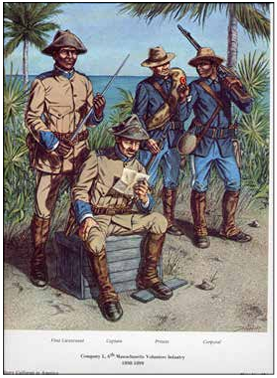
William Feix worked strictly as a wholesaler. While Feix sold his soldiers and sailors in attractive boxed sets, he never put his company name on his boxes. Note that the label in figure 3 says only “Fine Enameled Pewter Figures.” To date, no one has ever found a Feix catalog, as they would have only been made for selling direct to retailers. O’Brien discovered in a 1908 issue of Playthings magazine an ad from William Feix (without illustrations) suggesting a widely expanded available line of soldiers and sailors. Another ad appeared in a 1909 issue. Again, Richard O’Brien scoured the contemporary trade publications and found a number of advertisements featuring Feix sets and figures from other retailers. O’Brien found the American toy distributor OwensKreiser listed Feix figures in their catalog as their only toy soldiers from 1919 until 1927, but they disappeared from the catalog after ’27. Richard also reported in a 2005 article in the OTSN that he had uncovered a heavily illustrated advertisement in a 1915 Butler Brothers catalog. This listed four different presentation sets of Feix ranging from 5 to 32 figures, and two more, including one with a cork gun, which may also be by Feix.
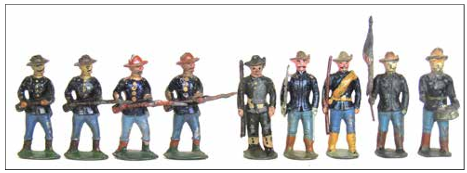
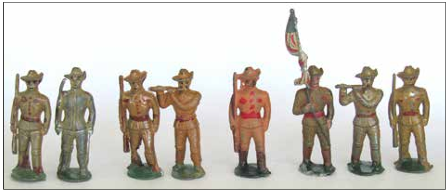
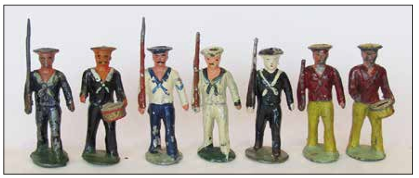
This is interesting in that Charles Beiser was locked in to presenting his Eureka sets as novel target games with a cork gun (or in their Britains game sets sold in England, a projectile-firing model cannon) to knock over the figures hinged to the baseboard and then flip the board to stand them back up. In contrast, Feix figures were typically sold just as a set of toy soldiers, letting the child’s imagination decide what best to do with them.
The period prior to the first World War seems to have been the zenith for Feix production, and the variety of castings we illustrate in this article may well reflect the acquisition of new molds expanding the line beyond just new paint schemes. Just prior to Feix initiating his production, the US was involved in the Spanish American war (1898) which involved the US Army, Navy, and various militia units (precursor of today’s National Guard), including Teddy Roosevelt’s “Rough Riders.” (Figure 4). Both the dress uniform (dark blue tunics, light blue trousers and black pickelhaube helmet), as well as the new winter dress (Figure 5, dark blue tunic, light blue trousers and Montana hat) and summer uniforms (Figure 6, khaki uniform with Montana hat) were featured by Feix. You can see both variations in illustrations of the Rough Riders at the battle of San Juan Hill. He also incorporated some of the gaudy and colorful uniforms of the east-coast militia units (most notable infantry and cavalry dressed in red or grey tunics), seen prior to the edicts of uniformity for all military (National and Guard) units by the US military in 1909. Spanish American war sailors in either blue winter dress or white summer dress uniforms, with a wide-brimmed hat were also produced (Figure 7). The Feix Spanish troops wore only dress uniforms with dark blue tunics and maroon pants with a black spiked helmet (Figure 8), though while fighting in Cuba they actually wore a white undress tropical uniform.
Beyond the Spanish-American War (1898), Feix produced some really attractive figures from the RussoJapanese War (1904-1905). These included distinctive castings “on Guard” in green (Russians) and blue (Japanese) with officers (Figure 9), cannons with their national flag colors painted over the stars and stripes casting, and tents flying the national flags of each country. Feix made a very distinctive cannon that fired by a spring-loaded mechanism (Figure 10) and was in a filigree, garrison-mount housing, that was cast flat (in a basic 2-piece cavity mold) and folded up on the sides to hold the barrel.
They also offered horse-drawn artillery, with a more sophisticated gun and limber pulled by Feix/Heyde style horses. Besides the examples illustrated, the Detroit Historical society has one of these horse-drawn artillery units in a display of marching Feix figures (in red tunics and spiked helmets) in their “streets of Detroit” display in the toy shop window. We would suggest that this gun and limber combination was purchased directly from Germany by Feix, to be pulled by his cavalry horses cast with the appropriate teamster tack. They are quite unusual, while the single gun garrisonmount gun is more commonplace. Figure 11 shows two variations; one horse-drawn gun team with the riders dressed in spiked helmets, and another in plumed helmets. It is likely that the expense and trouble of getting these items to incorporate into their line made them limited (and now unusual), and promoted the advent of the more common gun on a garrison mount which could be easily cast in their home facility.
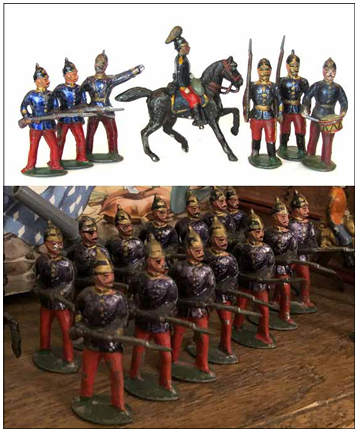
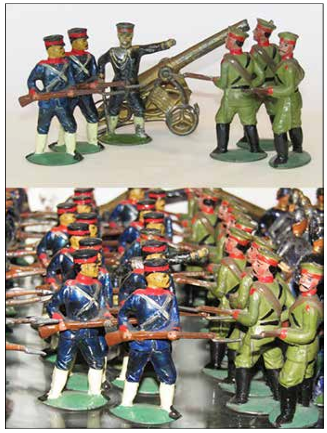

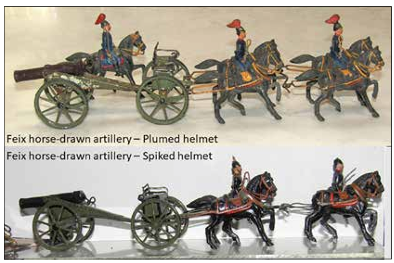
It is notable (and important) that Feix figures represented soldiers in the contemporary uniforms from prior to World War 1. These were the styles popular in the imperial period, with very American touches (e.g. the Montana hat). Feix never produced a distinctive American doughboy figure, despite their ubiquity through and almost a decade after the first world war. So why no doughboys? The USA were in the war only 2 years (1917-18). Remember, Feix’s molds all came from Germany, and to procure brass German molds of military figures during or after the war, with all the draconian limitations placed on the German economy, getting such molds, especially custom-made, would have been quite impossible.
After the war we see a number of small pop-up companies start producing toy soldiers, including figures in American doughboy uniforms. It is likely that some of these from the 1920s were able to procure some molds from Germany, but many were often crude copies of German figures made in solid cast in simple cavity molds for which the technology was readily available in the US. One such company was George Grampp (1908-1945). His soldiers were initially crude solid castings in the style of Heyde. Since he could make his own simple cavity molds, he could readily adapt them to portray the doughboy uniform. We have been told that later in his production he actually made some fairly nice hollowcast figures, but we have never seen these identified.
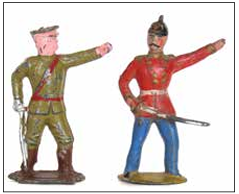
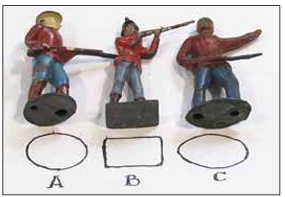
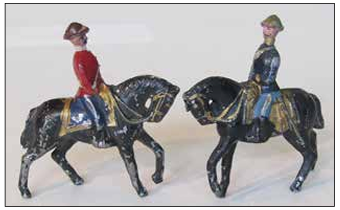
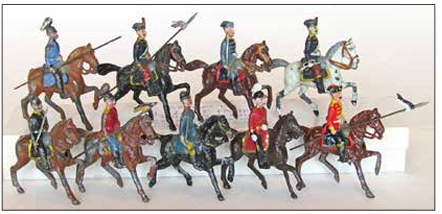
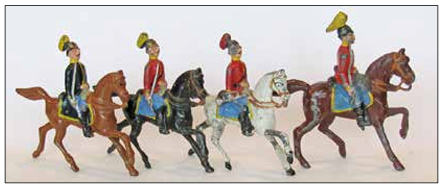
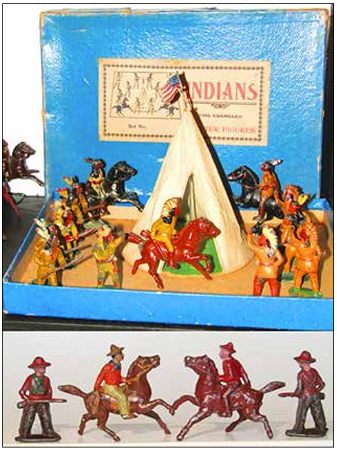
O’Brien’s research documents the shortlived (1922-23) Christies’ Metal Toy and Soldier Company which apparently used several molds of German origin, including the Feix-like marching sailor and two Native American Indians; chief and brave. Bill Nutting suggests the way to identify these Christies figures is to look for painting with “metallic” paints for the uniform and very flat paint on the bases. In perspective, keep in mind that Christies was a small 2-man operation only lasting over a year, so their production was likely very limited compared to 25 years of production by Feix.
Another contemporary American company was Theodore Hahn (1921-1927). Hahn also had a number of similar castings after the war, and a number of Doughboy-style hollowcast figures that O’Brien suggests had their origin, not from Germany but from France. Another company linked to Feix is Pearleytoys/Soljertoys (1928-1936) who copied the distinctive Feix officer pointing with his left hand, but with his sword pointing down (see Figure 12), and also made Indian braves which look like they are from old Feix molds. Their production coincides with the demise of Feix, suggesting they were a good candidate for procuring some old Feix molds. One other company named “Noebel, Widmann” or also called “Maiden America” (1915-1918) produced mostly solid Heyde-like or demi round figures from German cavity molds. In a 1917 Playthings magazine advertisement they illustrate four sets of figures including soldiers, sailors and cavalry. The sailors and some of the cavalry appear to be Feix figures, so either they also obtained some of the German molds, or more likely purchased figures directly from Feix to make up their own sets.
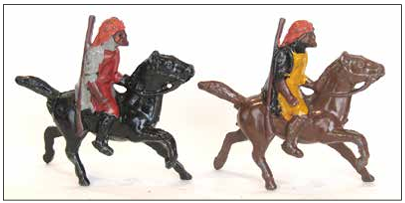

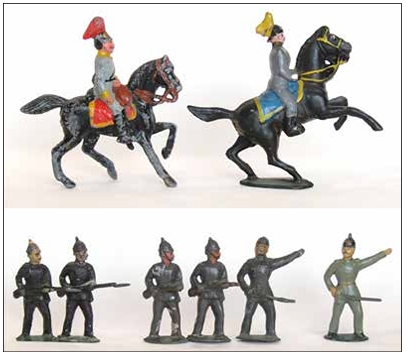
The foot figures of Feix were pretty limited in their scope, including their universal soldier “on guard” with bayonetted rifle, a marching figure “advance arms”, the pointing officer, a marching officer with a sword at the carry, a fifer, a drummer and a flagbearer with a partially furled flag and a distinctive spear-tip flag pole. Sailors seemed to have come only in the marching pose, including drummer, flag-bearer but we have never seen a naval officer for these sets. The major differences appear to be in either the paint scheme or the head gear; a spiked or plumed helmet, a Montana hat, a flat cap, a sailor’s wide-brimmed hat or some other less obvious headgear. It is highly likely that the German moldmakers had perfected swapping out the heads in the brass mold to add variety; a technique used by Britains Ltd. as well as probably by Feix for their infantry castings. The Feix figures are in 54 mm scale on an oval base of 2527 mm in length, and tend to be more robust in their sculpting compared to American Eureka or English Britain’s for Beiser (Figure 13). The oval base is a key to identifying them compared to the Eureka/Beiser figures. The Early Eureka figures had a very rounded oval base only 20-22 mm in length. In 1909 Eureka went completely to rectangular bases to fit in their new target gameset hinges, which was also adopted by Britains Ltd (sets #148, 149 and 188). They also used Heyde hollowcast infantry with the same rectangular base, as both Britains and Heyde had licenses to use Beiser’s game board.


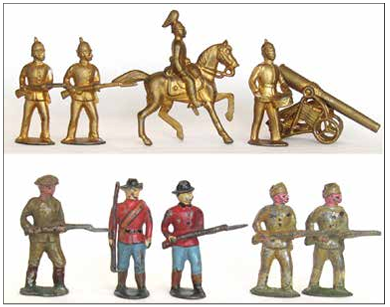
Feix mounted figures are primarily the walking horse in 54 mm scale (without a base) with the rider wearing either a spiked or plumed helmet or a Montana hat. Many came carrying a tin-strip sword that was inserted into the casting on the right hand, but if this is missing do not assume it has broken off. However, they also came with an officer on a rearing horse (with the rear legs on a triangular base), and also a more mundane mounted figure. Nutting attributes this to Feix (O’Brien’s catalog WF?22). The figure is mounted on a walking horse, with head down (and no base), reminiscent of Britain’s second grade cavalry (Figure 14). This figure has also been attributed to early Barclay production. Compared to the quality of other contemporary Feix figures, this may not actually be a Feix piece.
Heyde also employed these hollowcasting molds for their own more extensive line of mounted figures using the same horses but with more diverse headgear, including busbies, spiked, ball topped or plumed helmets, a kepi or a bearskin and carrying swords, lances, trumpets or other equipment (Figure 15). We have also found what appear to be Feix cavalry in a smaller scale of 45 mm, but otherwise virtually identical in either red or blue tunics and plumed helmets and distinctively American uniforms (Figure 16).
Feix also produced both mounted and foot cowboys and Indians (figure 17), as well as a rather unusual mounted Arab (Figure 18). O’Brien speculated that the cowboys and Indians and even the Arab were possibly designed as part of a “wild west show” set, but it’s more likely that cowboys and Indians were just always popular figures for American kids. Interestingly, Feix produced only one cowboy foot and one mounted figure, while making both a chief and a brave for each foot and mounted Indians. There were no foot Arabs.
As mentioned earlier, Feix made a very distinctive spring-loaded firing cannon and also a cloth tent mounted and stitched to a 4×4” heavy green cardboard base and held up by a single cross wire hooked into a single vertical pole that went through the top and ended in a flag. (Figure 19) This flag was painted as the stars and stripes, but also in other national flags matched to sets such as Russian and Japanese.
Early on (over 40 years ago) as a number of curious collectors were just beginning to study and appreciate American-made toy soldiers, we attributed everything to the paper lithography company McGloughlin (1840-1920), probably because a number of their magnificent paper lithographed boxes had survived with illustrations far nicer than their shortlived (1911–1914) metal soldiers that inhabited them. We also attributed the different (red) uniforms as a fictious “the enemy” rather than actually representing various colorful east coast militia units. Now, we find Feix figures painted in blue, red, khaki, grey, gilt (Figures 20-23), and sailors in various combinations of blue and white, and even red(?) (Figure 7). All of these previous studies and discoveries have led us to a much better understanding of the variety, the influence and the history of truly American makers who have brought us some of the most memorable and interesting toy soldiers. Of these, we find the artistry and unique character of William Feix figures to be some of our favorites.
Bibliography
Richard O’Brien. Collecting American-made Toy Soldiers. Identification and Value Guide. (Edition 3). Pages 1, 13, 18, 34, 43, 48, 52, 54, 434: Books Americana, 1997.
Richard O’Brien. Researching America-made Toy soldiers: 32 years of Articles. Pages 104, 113, 125, 133, 141, 162, 216, 227, 229. Ramble House. 2009.
Ed K. Poole. Homecast. In Richard O’Brien’s Collecting American-made Toy Soldiers. Pages 602-603 (Schneider/Schiercke). Books Americana, 1997.
Will Beierwaltes and G. Scott Morlan. Britains Ltd. and Beiser Games. Old Toy Soldier Newsletter. Vol 6, No. 6, 1982.
Will Beierwaltes and Joe Wallis. Britains Invasion of America. Old Toy Soldier Newsletter. Vol. 4, No. 4, pp 1-6. 1980.
Henry F. Anton. Ideal; An American 20’s Firm. Old Toy Soldier Newsletter. Vol. 3, No. 4, pp 1-2. 1979.
Joe Wallis. Soldiers of Greater Britain; Britains Limited Lead Soldiers 1893-1924. Self-published by Joe Wallis, 2017.
